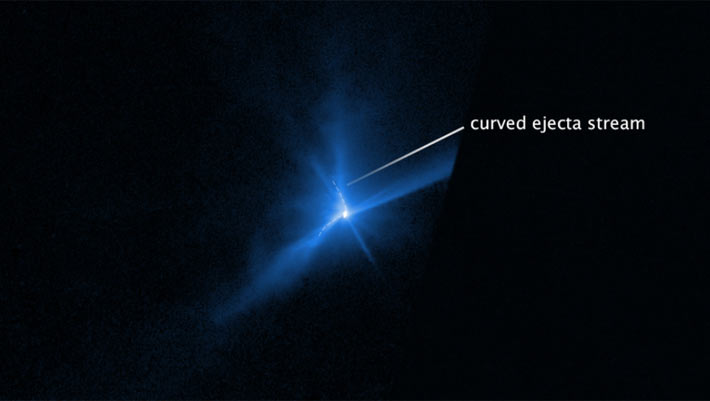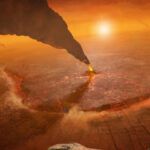On September 26, 2022, NASA’s Double Asteroid Redirection Test (DART) intentionally slammed into the 160-m-wide asteroid moonlet Dimorphos — which orbits the larger, 780-m-wide asteroid Didymos — for the first planetary defense test. In a new series of papers published in the journal Nature, the DART team detailed the spacecraft’s successful impact, the possible physics behind the collision, observations of the resulting debris ejected from moonlet and calculations of Dimorphos moonlet’s orbital changes. The findings confirm the feasibility of redirecting near-Earth objects like asteroids as a planetary defense measure.
These three Hubble images capture the breakup of Dimorphos when it was deliberately hit by DART on September 26, 2022. The top panel, taken 2 hours after impact, shows an ejecta cone (an estimated 1,000 tons of dust). The center frame shows the dynamic interaction within the Didymos-Dimorphos binary system that starts to distort the cone shape of the ejecta pattern about 17 hours after the impact. The most prominent structures are rotating, pinwheel-shaped features. The pinwheel is tied to the gravitational pull of Didymos. In the bottom frame, Hubble captures debris being swept back into a comet-like tail by the pressure of sunlight on the tiny dust particles. This stretches out into a debris train where the lightest particles travel the fastest and farthest from the asteroid. The mystery is compounded when Hubble records the tail splitting in two for a few days. Image credit: NASA / ESA / STScI / Jian-Yang Li, PSI / Joseph DePasquale, STScI.
“We can’t stop hurricanes or earthquakes yet, but we ultimately learned that we can prevent an asteroid impact with sufficient time, warning and resources,” said Professor Derek Richardson, a researcher at the University of Maryland.
“With sufficient time, a relatively small change in an asteroid’s orbit would cause it to miss the Earth, preventing large-scale destruction from occurring on our planet.”
“The DART impact happened in a binary asteroid system,” said Dr. Jian-Yang Li, a researcher at the Planetary Science Institute.
“We’ve never witnessed an object collide with an asteroid in a binary asteroid system before in real time, and it’s really surprising.”
“I think it’s fantastic. Too much stuff is going on here. It’s going to take some time to figure out.”
Using data from spacecraft engineers and from the Didymos Reconnaissance and Asteroid Camera for Optical Navigation (DRACO), the DART researchers determined what the spacecraft was looking at as it approached Dimorphos.
“When dealing with observations from a spacecraft, we need to understand where in space the spacecraft is located with respect to the asteroid, the Sun and Earth and where it’s facing at any given time,” said Dr. Tony Farnham, also from the University of Maryland.
“With this information, we have the context to make our conjectures and evaluate our work.”
The scientists gained important information about the general timeline of the impact, the location and nature of the impact site, and the size and shape of Dimorphos.
To their surprise, they found the small asteroid to be an oblate spheroid, or a slightly squashed sphere-like body, instead of a more elongated shape expected from theoretical predictions.
“Both Didymos and Dimorphos are more squishy in shape than we expected,” said University of Maryland’s Professor Jessica Sunshine.
“This shape also challenges some of our preconceptions about how such asteroids form and complicates the physics behind DART because it prompts us to rethink our current models of binary asteroids.”
In addition to Dimorphos’ irregular shape, the team also noticed that the asteroid’s surface was noticeably bouldery and blocky.
This geomorphic quality likely influenced crater formation, the amount and physical properties of ejecta, and the momentum of a DART-like impact.
The authors observed that these different textural qualities led to different impact outcomes — critical in evaluating how successfully the DART spacecraft redirected Dimorphos from its original orbit.
“The Deep Impact mission collided with a comet whose surface is made up of small, mostly uniform grains,” Professor Sunshine said.
“Deep Impact resulted in a more uniform fan of debris than the filamentary structures seen after DART’s impact into bouldery terrain.”
“As it turns out, the movement of DART-caused ejecta really had a profound effect on the success of DART’s mission.”
The DART spacecraft was not the sole provider of momentum in the impact with Dimorphos.
An additional shove was caused by violent spews of debris when the spacecraft slammed into the diminutive asteroid moon.
“There was so much debris ejected from the impact that Dimorphos was pushed approximately 3.5 times more effectively compared to being hit by the DART spacecraft alone,” Professor Richardson said.
This finding was confirmed when the team measured the asteroid’s orbit had changed more than the team’s more conservative expectations.
The difference in orbital periods, or the length of time it takes for a celestial object to complete one rotation around another object, indicates that the orbit of Dimorphos around Didymos had changed.
“Pre-impact, we expected the impact to shorten Dimorphos’ orbit by only about 10 minutes,” Dr. Farnham said.
“But after the impact, we learned that the orbital period was shortened even more, reducing an ordinarily 12-hour orbit by slightly more than 30 minutes.”
“In other words, the ejected material acted as a jet to push the moon even further out of its original orbit.”




